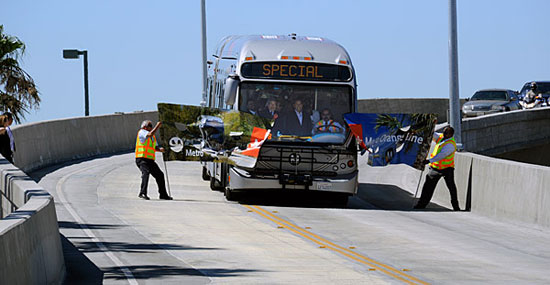Orange Line’s “dismal” fare findings
January 16, 2014

The Orange Line, shown at opening of the busway's extension, is popular but many aren't paying to ride.
Up to 22% percent of Orange Line passengers were deliberate fare evaders and as many as 9% “misused” their TAP cards, according to recent audits assessing the extent of fare-beating on the popular San Fernando Valley dedicated busway.
The findings, presented Wednesday to a Metro committee, are “rather dismal,” acknowledged Duane Martin, the agency’s deputy executive officer for project management.
“We understand there’s no glossing over the significant fare evasion,” Martin said, although he added that the recent redeployment of sheriff’s deputies to check fares along the line has improved the situation.
The Orange Line carries about 30,000 riders a day, and unlike the rest of Metro’s fleet, does not have fare boxes on its buses. Instead, it relies on patrons at un-gated stations to tap their fare cards at machines known as “stand alone validators.”
Many, it appears, have been taking advantage of the system to hitch a free ride.
Two audits—conducted December 3 and December 17—surveyed all patrons as they got off the bus at various Orange Line stations. The first audit, at the North Hollywood, Van Nuys and Sherman Way stations, found 22% fare evasion (traveling without a TAP card or using a card with no value on it) and 9% TAP card misuse (having a valid TAP card but, perhaps inadvertently, failing to properly tap it before entering the bus.) The second audit, at the North Hollywood, Reseda and Canoga stations, found 16% fare evasion and 8% TAP card misuse.
The audits were prompted by a November, 2013, motion by Supervisor Zev Yaroslavsky, a member of Metro’s Board of Directors and a longtime proponent of reforms to help eliminate free riders on the Los Angeles transit system. In a major milestone, gates on the L.A. subway, which for years had operated on the honor system, were finally latched last year. But locking down Metro’s light rail system and the Orange Line, which operates in a similar fashion, is still a challenge.
On Wednesday, Yaroslavsky and another director, Los Angeles City Councilman Paul Krekorian, responded to the Orange Line audit findings with another motion, this one directing Metro staff to explore installing gates at the busway’s stations. They also said that signs explaining that tapping is mandatory (and listing fines for failing to do so) should be placed on or beside the ticket validating machines at the stations.
Moreover, they asked for status reports on gate installation for projects currently being constructed or designed, including phase two of the Expo Line, the Foothill extension of the Gold Line, and the Crenshaw Line.
“Unless we take this issue head-on, and begin to design stations with gates…fare evasion will continue to skyrocket and become a perpetual problem with no end in sight,” the motion said.
“Saturating” the Orange Line with sheriff’s deputies checking fare cards has already started having an impact, including in the period between the first and second audit, Metro deputy executive officer Martin said.
“The deputies are out there so people started tapping again,” he said.
Before Martin reports back to Metro’s board members on the issue in March, he plans to conduct another Orange Line audit, probably next month.
Wiping out all fare evasion is unrealistic, he said, but there is lots of room for improvement. “I would love to be able to operate the system with plus or minus 2% or 3% fare evasion,” Martin said. “That’s the goal.”
Posted 1/16/14












 405 bridge work causes a stink
405 bridge work causes a stink

